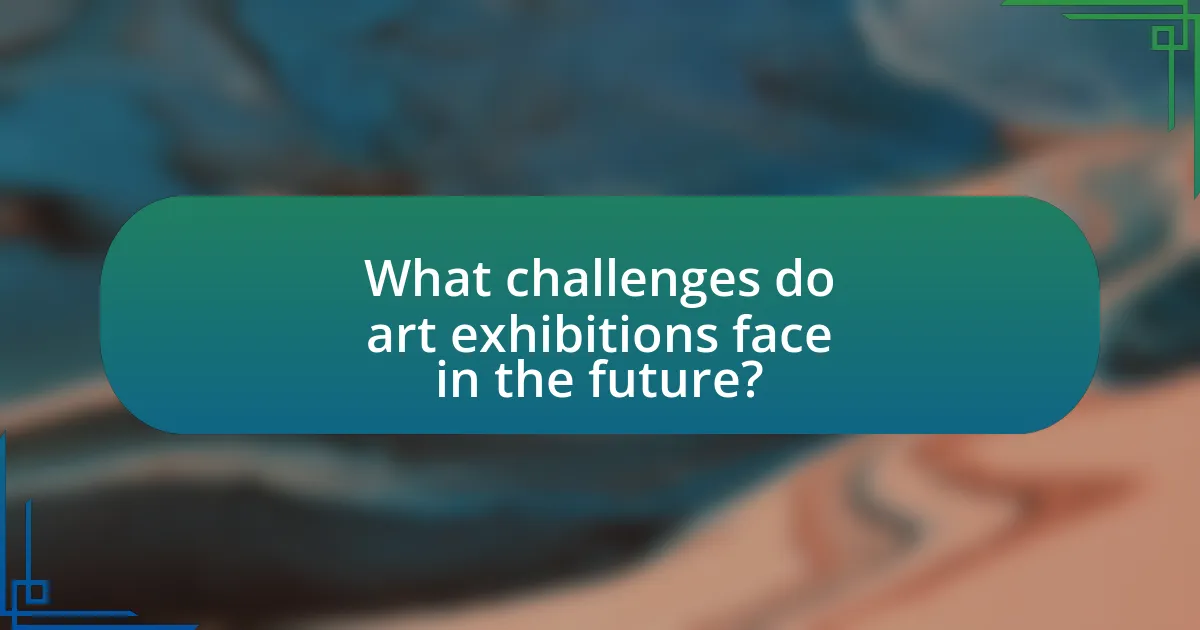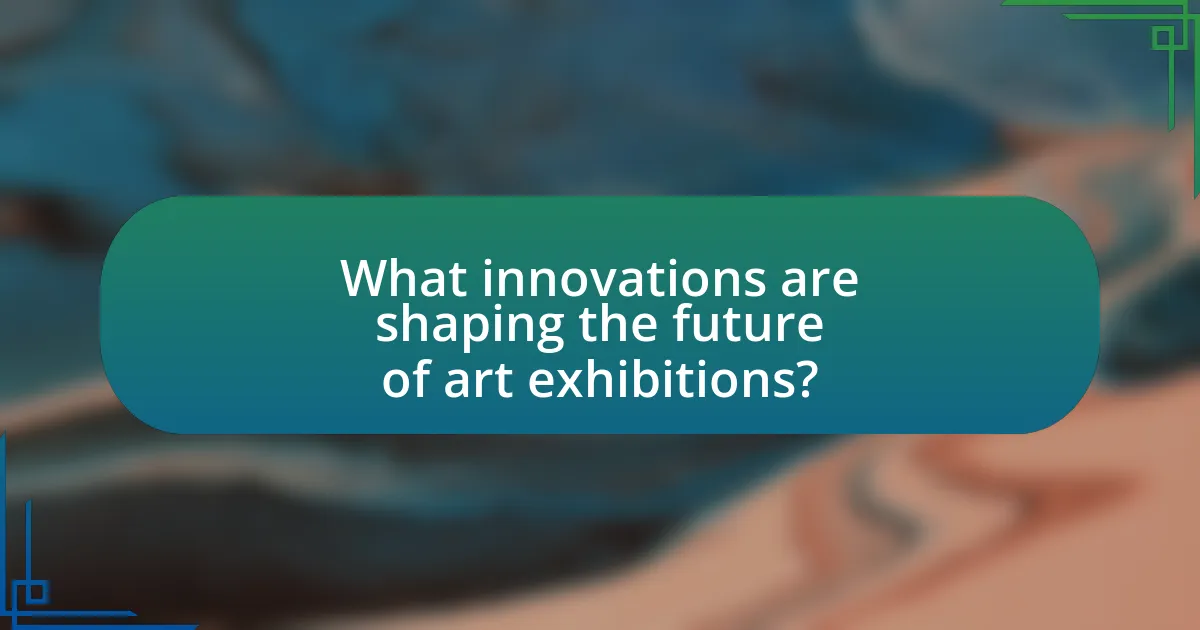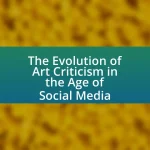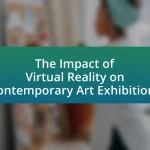The article focuses on the future of art exhibitions, highlighting emerging trends such as the integration of technology, inclusivity, and sustainability. It discusses how virtual and augmented reality are transforming visitor engagement by creating immersive experiences, while digital platforms are expanding accessibility to global audiences. Additionally, the article examines shifts in audience demographics, the impact of economic conditions on exhibitions, and the importance of sustainable practices in the art world. Key challenges and innovations shaping the future of art exhibitions are also addressed, providing a comprehensive overview of the evolving landscape in this sector.

What are the emerging trends in art exhibitions?
Emerging trends in art exhibitions include the integration of technology, such as virtual reality and augmented reality, to enhance visitor engagement. These technologies allow for immersive experiences that transform traditional viewing into interactive participation. For instance, exhibitions like “The Night Cafe” use virtual reality to recreate Vincent van Gogh’s famous painting, allowing visitors to explore the environment in a 3D space. Additionally, there is a growing emphasis on inclusivity and diversity, with more exhibitions showcasing underrepresented artists and perspectives, reflecting a broader cultural narrative. This trend is supported by initiatives from institutions like the Museum of Modern Art, which actively seeks to diversify its collection and programming. Furthermore, sustainability is becoming a key focus, with exhibitions increasingly adopting eco-friendly practices, such as using recycled materials and reducing carbon footprints, as seen in the practices of the Serpentine Gallery in London. These trends indicate a significant shift towards more interactive, inclusive, and environmentally conscious art exhibitions.
How is technology influencing the future of art exhibitions?
Technology is significantly influencing the future of art exhibitions by enhancing visitor engagement and expanding accessibility. Innovations such as virtual reality (VR) and augmented reality (AR) allow audiences to experience art in immersive environments, creating interactive experiences that traditional exhibitions cannot offer. For instance, the use of VR in exhibitions like “The Night Cafe” enables viewers to step into a digital recreation of Van Gogh’s famous painting, providing a unique perspective on the artwork. Additionally, online platforms and digital galleries have made art more accessible to global audiences, as seen during the COVID-19 pandemic when many institutions transitioned to virtual tours, reaching millions who might not visit in person. These technological advancements not only enrich the viewing experience but also democratize access to art, shaping the future landscape of art exhibitions.
What role do virtual and augmented reality play in art exhibitions?
Virtual and augmented reality significantly enhance art exhibitions by providing immersive experiences that engage audiences in innovative ways. These technologies allow visitors to interact with artworks and environments that would be impossible or impractical in a traditional setting. For instance, virtual reality can transport viewers to different locations or time periods, enabling them to experience art in context, while augmented reality can overlay digital information onto physical artworks, enriching the viewer’s understanding and appreciation. A notable example is the “Van Gogh: The Immersive Experience” exhibition, which uses VR to place visitors inside Van Gogh’s paintings, demonstrating how these technologies can transform the way art is experienced.
How are digital platforms changing the way art is displayed?
Digital platforms are transforming art display by enabling virtual exhibitions and interactive experiences. These platforms allow artists to reach global audiences without geographical limitations, as seen in initiatives like the Google Arts & Culture project, which features over 2,000 museums and galleries worldwide. Additionally, augmented reality (AR) and virtual reality (VR) technologies enhance viewer engagement by allowing users to interact with art in immersive environments. For instance, the VR platform Oculus has hosted exhibitions that let users explore artworks in 3D spaces, thereby redefining traditional viewing experiences. This shift not only democratizes access to art but also fosters innovative ways for artists to present their work.
What shifts are occurring in audience engagement at art exhibitions?
Shifts in audience engagement at art exhibitions include increased interactivity, the use of technology, and a focus on inclusivity. Audiences are now seeking immersive experiences that allow them to participate actively rather than passively observe. For instance, the integration of augmented reality and virtual reality in exhibitions has transformed how visitors interact with art, making it more engaging and personalized. Additionally, art institutions are prioritizing diverse programming that reflects a broader range of voices and perspectives, which has been shown to attract wider audiences. According to a report by the National Endowment for the Arts, 53% of adults in the U.S. engaged with the arts through digital platforms in 2021, indicating a significant shift towards online and hybrid experiences.
How are interactive installations enhancing visitor experiences?
Interactive installations enhance visitor experiences by fostering engagement and participation, allowing individuals to actively interact with the artwork. This interactivity transforms passive observation into an immersive experience, encouraging deeper emotional connections and personal interpretations of the art. Research indicates that visitors are more likely to remember and appreciate exhibitions that involve interactive elements, as these installations stimulate curiosity and creativity. For instance, a study published in the Journal of Museum Education found that interactive exhibits increased visitor satisfaction by 30%, demonstrating the effectiveness of such installations in enhancing overall experiences.
What new demographics are being attracted to art exhibitions?
Art exhibitions are increasingly attracting younger audiences, particularly millennials and Generation Z. This demographic shift is evidenced by a rise in attendance from individuals aged 18 to 34, who are drawn to interactive and immersive experiences that blend technology with traditional art forms. According to a 2022 report by the National Endowment for the Arts, 45% of art attendees in this age group expressed a preference for exhibitions that incorporate digital elements, such as virtual reality and social media engagement, highlighting a significant change in how art is consumed and appreciated.

What challenges do art exhibitions face in the future?
Art exhibitions will face challenges such as adapting to digital transformation, engaging diverse audiences, and addressing sustainability concerns. The rise of virtual and augmented reality technologies demands that exhibitions integrate these tools to enhance visitor experiences, as evidenced by the increasing number of online exhibitions during the COVID-19 pandemic, which saw a 300% increase in virtual attendance. Additionally, art institutions must find ways to attract and retain a broader demographic, particularly younger audiences who prioritize inclusivity and social relevance. Lastly, the push for environmentally sustainable practices in the art world necessitates that exhibitions reduce their carbon footprint, with many institutions committing to sustainability goals, such as the Museum of Modern Art’s initiative to achieve carbon neutrality by 2030.
How is the economic landscape affecting art exhibitions?
The economic landscape significantly affects art exhibitions by influencing funding, attendance, and the types of artworks showcased. Economic downturns often lead to reduced sponsorship and grants, which can limit the scale and frequency of exhibitions. For instance, during the 2008 financial crisis, many galleries reported a decline in visitor numbers and sales, prompting a shift towards more accessible and community-focused exhibitions. Additionally, fluctuating disposable income levels impact consumer spending on art, which can affect ticket sales and art purchases at exhibitions. According to a report by the National Endowment for the Arts, economic conditions directly correlate with public engagement in the arts, highlighting that stronger economies typically see increased attendance and participation in art events.
What impact does funding have on the sustainability of art exhibitions?
Funding significantly impacts the sustainability of art exhibitions by providing the necessary financial resources for operational costs, marketing, and artist compensation. Adequate funding ensures that exhibitions can cover expenses such as venue rental, installation, and promotional activities, which are crucial for attracting visitors and maintaining public interest. For instance, a study by the National Endowment for the Arts found that exhibitions with robust funding are more likely to engage diverse audiences and offer educational programs, thereby enhancing their long-term viability. Additionally, consistent financial support allows curators to plan future exhibitions with greater confidence, fostering innovation and creativity in the art sector.
How are art institutions adapting to changing economic conditions?
Art institutions are adapting to changing economic conditions by diversifying revenue streams and enhancing digital engagement. Many institutions are implementing membership programs, hosting virtual exhibitions, and offering online educational content to reach broader audiences and generate income. For instance, the Museum of Modern Art in New York reported a significant increase in online membership during the pandemic, which helped offset losses from reduced physical attendance. Additionally, art institutions are collaborating with private sectors and leveraging sponsorships to secure funding, as seen in partnerships between galleries and tech companies for innovative exhibitions. These strategies demonstrate a proactive approach to maintaining financial stability in fluctuating economic climates.
What are the environmental considerations for future art exhibitions?
Environmental considerations for future art exhibitions include sustainable materials, energy-efficient lighting, waste reduction, and carbon footprint minimization. Art institutions are increasingly adopting eco-friendly practices, such as using recycled or biodegradable materials for installations and displays. For instance, the use of LED lighting can reduce energy consumption by up to 75% compared to traditional lighting, significantly lowering the environmental impact. Additionally, many exhibitions are implementing strategies to minimize waste, such as digital catalogs instead of printed materials and reusable display structures. These practices not only contribute to environmental sustainability but also align with the growing public demand for responsible and ethical art practices.
How can art exhibitions reduce their carbon footprint?
Art exhibitions can reduce their carbon footprint by implementing sustainable practices such as using energy-efficient lighting, sourcing materials locally, and minimizing waste. Energy-efficient lighting, like LED bulbs, can reduce energy consumption by up to 75% compared to traditional lighting, significantly lowering greenhouse gas emissions. Sourcing materials locally not only reduces transportation emissions but also supports local economies. Additionally, minimizing waste through recycling and composting can further decrease the environmental impact of exhibitions. According to a study by the Arts Council England, adopting these sustainable practices can lead to a 30% reduction in carbon emissions for cultural events.
What sustainable practices are being adopted in the art world?
Sustainable practices in the art world include the use of eco-friendly materials, energy-efficient lighting, and waste reduction strategies. Many artists and galleries are now opting for sustainable materials such as recycled paper, organic paints, and biodegradable sculptures. Additionally, art institutions are implementing energy-efficient lighting systems to reduce electricity consumption, which can decrease their carbon footprint significantly. For instance, the Tate Modern in London has adopted a sustainability strategy that includes reducing energy use by 20% by 2025. Furthermore, waste reduction initiatives, such as reusing exhibition materials and minimizing single-use plastics, are becoming standard practices in art exhibitions. These efforts reflect a growing commitment within the art community to address environmental concerns and promote sustainability.

What innovations are shaping the future of art exhibitions?
Innovations shaping the future of art exhibitions include virtual reality (VR), augmented reality (AR), and artificial intelligence (AI). These technologies enhance visitor engagement by creating immersive experiences that allow audiences to interact with art in novel ways. For instance, VR enables users to explore digital galleries from anywhere in the world, while AR can overlay digital information onto physical artworks, enriching the viewing experience. Additionally, AI is being utilized for curatorial purposes, analyzing visitor data to personalize exhibitions and improve accessibility. These advancements are supported by the increasing integration of technology in cultural institutions, as evidenced by the rise of virtual exhibitions during the COVID-19 pandemic, which demonstrated the potential for broader audience reach and engagement.
How are curatorial practices evolving in response to new trends?
Curatorial practices are evolving to incorporate digital technologies, interdisciplinary approaches, and community engagement in response to new trends. The integration of virtual and augmented reality allows curators to create immersive experiences that enhance audience interaction, as seen in exhibitions like the “Van Gogh: The Immersive Experience,” which attracted over 2 million visitors globally. Additionally, curators are increasingly collaborating with artists from diverse backgrounds and disciplines, fostering inclusivity and reflecting contemporary societal issues. This shift is evidenced by initiatives such as the 2021 Venice Biennale, which featured a record number of artists from underrepresented communities. Furthermore, curatorial practices are emphasizing sustainability and ethical considerations, aligning with global movements towards environmental responsibility in the arts.
What new formats are being explored for art exhibitions?
New formats being explored for art exhibitions include immersive experiences, virtual reality installations, and hybrid models that combine physical and digital elements. Immersive experiences engage audiences by allowing them to interact with the artwork in a multi-sensory environment, as seen in exhibitions like TeamLab Borderless in Tokyo. Virtual reality installations enable viewers to explore art in a digital space, expanding accessibility and creativity, exemplified by projects like The Night Cafe, which recreates Van Gogh’s famous painting in a 3D environment. Hybrid models, which integrate online platforms with traditional gallery spaces, have gained traction, particularly during the COVID-19 pandemic, as they allow for broader audience reach and engagement.
How is collaboration between artists and technologists influencing exhibitions?
Collaboration between artists and technologists is significantly enhancing exhibitions by integrating innovative technologies that create immersive experiences. This partnership allows artists to utilize tools such as virtual reality, augmented reality, and interactive installations, which engage audiences in novel ways. For instance, the use of augmented reality in exhibitions has been shown to increase visitor interaction and retention, as evidenced by the success of projects like the “AR Museum” in 2020, which reported a 40% increase in visitor engagement compared to traditional exhibitions. Such collaborations not only expand the creative possibilities for artists but also attract a broader audience, thereby transforming the landscape of art exhibitions.
What best practices can be adopted for successful future art exhibitions?
Successful future art exhibitions can be achieved by implementing effective audience engagement strategies, utilizing technology, and ensuring strong marketing efforts. Engaging the audience through interactive installations and workshops fosters a deeper connection with the artwork, as evidenced by the success of exhibitions like the Van Gogh Immersive Experience, which attracted over 2 million visitors globally. Additionally, incorporating technology such as augmented reality can enhance the viewing experience, as seen in the 2019 “Frida Kahlo: Appearances Can Be Deceiving” exhibition, which utilized AR to bring Kahlo’s work to life. Finally, robust marketing campaigns that leverage social media and partnerships with influencers can significantly increase visibility and attendance, demonstrated by the record-breaking attendance at the “David Bowie Is” exhibition, which utilized targeted digital marketing strategies.
How can art institutions effectively integrate technology into exhibitions?
Art institutions can effectively integrate technology into exhibitions by utilizing interactive displays, augmented reality, and digital storytelling. Interactive displays engage visitors by allowing them to manipulate content, enhancing their experience and understanding of the artwork. Augmented reality can overlay digital information onto physical art pieces, providing context and deeper insights, which has been shown to increase visitor engagement by up to 30%. Digital storytelling through multimedia presentations can create immersive narratives that connect audiences emotionally to the art, as evidenced by institutions like the Museum of Modern Art, which reported increased visitor satisfaction when incorporating such technologies.
What strategies can enhance visitor engagement and satisfaction?
To enhance visitor engagement and satisfaction, art exhibitions can implement interactive technologies, such as augmented reality (AR) and virtual reality (VR), which allow visitors to experience art in immersive ways. Research indicates that exhibitions incorporating AR and VR can increase visitor interaction by up to 50%, as these technologies create a more dynamic and participatory environment. Additionally, providing personalized experiences through tailored content and guided tours can significantly improve visitor satisfaction, with studies showing that personalized interactions lead to a 30% increase in positive feedback. Engaging visitors through social media platforms before, during, and after the exhibition also fosters a sense of community and connection, further enhancing their overall experience.




